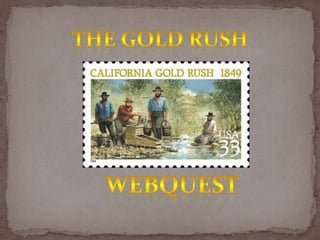
The Gold Rush Webquest
- 2. The largest group of settlers in the Mexican Cession were the Mormons Also called the Church of Jesus Christ of Latter Day Saints Started by Joseph Smith in upstate New York in 1830 Smith believed that all property should be held in common He also believed that a man could have more than one wife Question: Who established the Church of Jesus Christ Latter Day Saints?
- 3. 1. Who established the Church of Jesus Christ Latter Day Saints? 2. Why did a mob attack and kill Smith? 3. Who assumed leadership of the Mormon Church after the death of Joseph Smith? 4. What city is the home of the Mormon Church? 5. Why is the Great Salt Lake so salty? 6. Where was gold discovered? 7. What were the people who migrated to California in 1849 called? 8. How did most forty-niners get to California? 9. What was life like in a mining camp? 10. What is a vigilante? 11. When was California admitted to the Union?
- 4. Angry neighbors in New York forced the Mormons to move to Ohio, then Missouri, and then to Illinois The Mormons built a community called Nauvoo on the banks of the Mississippi River in 1840 Joseph Smith was arrested in 1844 An angry mob attacked the jail and killed Smith Question: Why did a mob attack and kill Smith? Carthage Jail
- 5. The Mormons chose Brigham Young as their new leader Young realized that the Mormons needed a refuge-a place safe from persecution He led a large group of pioneers west to the Great Basin located between the Rocky Mountains and the Great Salt Lake in 1847 Young planned an irrigation system to bring water to the farms in the desert region of the Great Basin Question: Who assumed leadership of the Mormon Church after the death of Joseph Smith?
- 6. Brigham Young drew up plans for a large city, called Salt Lake City, to be build in the desert Young established a fund to help bring thousands of Mormons to Utah Young became governor of the Utah Territory Question: What city is the home of the Mormon Church? Salt Lake Temple
- 7. The Great Salt Lake is the largest natural lake west of the Mississippi River The Great Salt Lake is salty because it does not have an outlet (a way for water to leave other than evaporation) Tributary rivers are constantly bringing in small amounts of salt dissolved in their fresh water flow. Once in the lake much of the water evaporates leaving the salt behind. The water is 3 to 5 times saltier then ocean water Started as Lake Bonneville formed during the last Ice Age Question: Why is the Great Salt Lake so salty?
- 8. In January 1848, James Marshall was building a sawmill for Captain John Sutter using water from the South Fork of the American River when he saw some gold flakes in the water. He right away that they were gold. He tried to keep his discovery secret but the news reached San Francisco within days Soon thousands of people were rushing to California Question: Where was gold discovered?
- 9. They came from Europe, China, Australia, and South America The 80,000 – 100,000 people who made the journey to California were called forty-niners Among the forty-niners were thousands of free blacks and tens of thousands of young Chinese men Many faced prejudice because their language, food, and clothing were different Native Americans were driven off their lands Many died of starvation and disease Question: What were the people who migrated to California in 1849 called?
- 10. Many people travelled the overland route across the Plains and through one of the mountain passes Others tried the 17,000 mile sea voyage from the Atlantic coast around Cape Horn and up to California which took five months An alternative was to sail to Panama, cross the isthmus on horseback, than sail up the west coast to California Question: How did most forty- niners get to California?
- 11. Miners lived in canvas tents in mining camps cooking their meals on open fires. Sanitation was poor and miners seldom bathed or washed their clothes. Colds and other diseases were common among miners due to poor nutrition. The winters with heavy rains and snow forced many miners to head to San Francisco. Murders and robberies were common in mining towns Question: What was life like in a mining camp?
- 12. Punishment for criminal behavior was not always just, but it was quick Citizens formed vigilance committees to stop crime Vigilantes were self-appointed law enforcers Miners had little time for courts, juries or lawyers. Justice was dispensed by "Judge Lynch" -- in the form of mobs that held impromptu trials and handed out immediate punishment, often whipping or hanging A lynching is a hanging without a legal trial Question: What is a vigilante?
- 13. Californians realized that they needed a strong government to protect the rights of citizens In 1849 a state constitution was written California asked to be admitted to the Union Americans asked if California would allow slavery In 1850, California was admitted as a free state Question: When was California admitted to the Union?